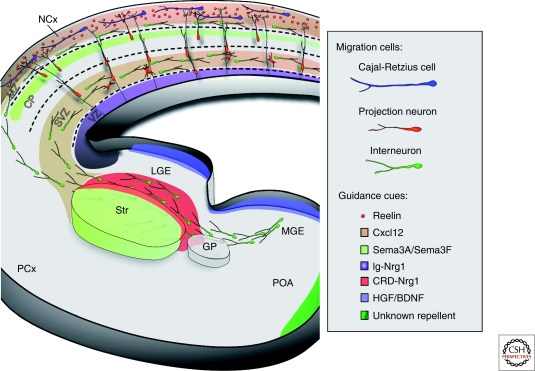Figure 4.
Guidance cues and neuronal migration in the telencephalon. The schema shows a coronal slice of the telencephalon at midembryonic stages, in which the main cortical migrations and their guidance cues are indicated. Interneurons born in the medial ganglionic eminence (MGE) migrate tangentially through the subpallium to reach the cortex. Some of these interneurons enter the striatum (striatal interneurons), whereas others continue toward the cortex (cortical interneurons), sorting out through a mechanism that involves Sema3A and Sema3F. Cortical interneurons advance toward the cortex following a corridor of lateral ganglionic eminence (LGE)-derived cells that express CRD-Nrg1 but not semaphorins. Interneurons are guided toward the cortex by a combination of motogenic (HGF/BDNF) and chemoattractive factors (Ig-Nrg1). Once in the cortex, chemokine signaling (Cxcl12) restricts the migration of interneurons through two streams, the marginal zone (MZ) and the subventricular zone (SVZ). Cajal-Retzius cells also use Cxcl12 to disperse through the MZ in opposite direction to interneurons. Cajal-Retzius cells produce Reelin, which along with other factors such as semaphorins, guide the migration of projection neurons. (CP) cortical plate; (GP) globus pallidum; (IZ) intermediate zone; (MZ) marginal zone; (NCx) neocortex; (PCx) piriform cortex; (Str) striatum; (SVZ/VZ) subventricular/ventricular zones.

